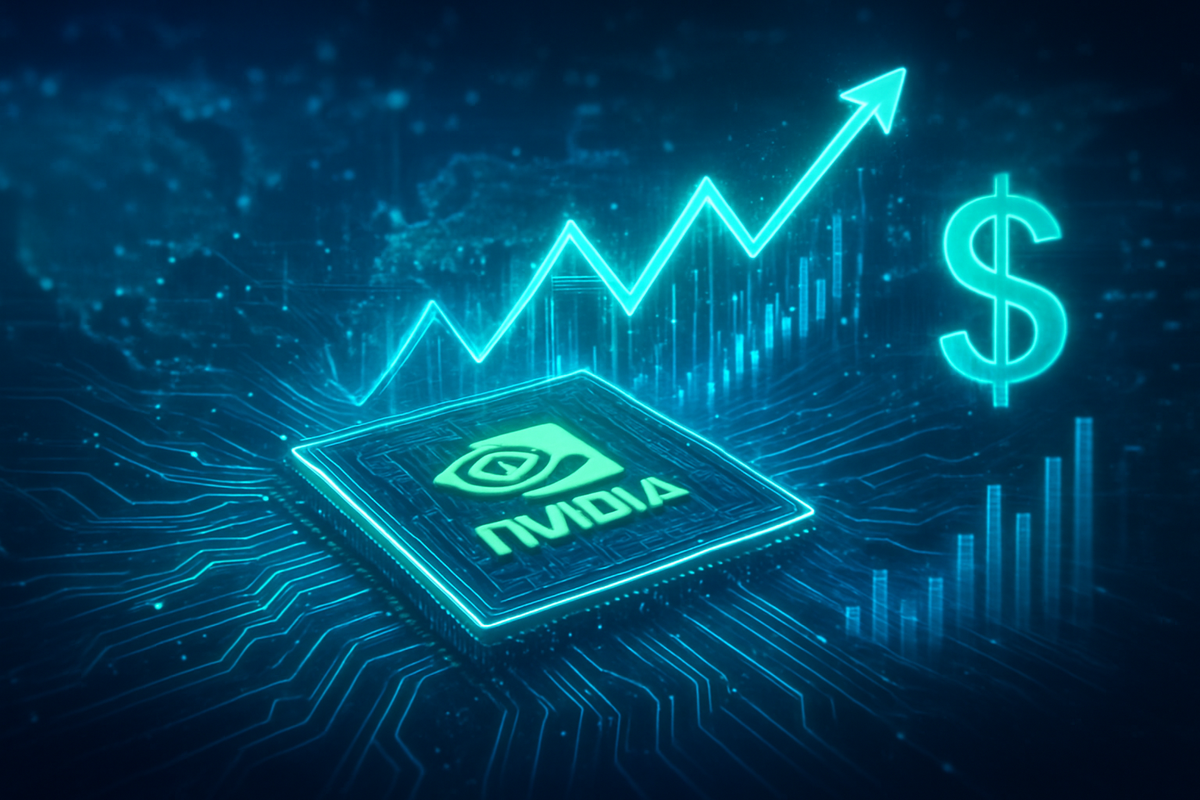
As the financial world braces itself, Nvidia Corporation (NASDAQ: NVDA) is poised to release its highly anticipated third-quarter fiscal year 2026 earnings report after market close on Wednesday, November 19, 2025. This upcoming announcement is not merely a routine financial disclosure; it stands as a critical bellwether for the entire artificial intelligence (AI) sector and is expected to send significant ripple effects across the broader technology market and global economy. Investors, analysts, and industry observers are keenly awaiting the results, understanding that Nvidia's performance and, more crucially, its forward guidance, will likely dictate market sentiment for the remainder of the year and well into 2026.
The stakes are exceptionally high. Nvidia's unparalleled dominance in the AI chip market has positioned it as a barometer for the health and trajectory of the AI revolution. Any deviation from the projected robust growth, or any nuanced commentary on future demand and supply chains, could trigger substantial volatility. The market is not just looking at past performance but is actively seeking validation for the massive capital expenditures currently flowing into AI infrastructure, making this earnings call a pivotal moment that could either reinforce bullish sentiment or ignite concerns about an overheating market.
The Eve of Expectation: What Wall Street Anticipates
The financial community is buzzing with expectations for Nvidia's Q3 FY2026 report, which covers the period ending October 2025. Analyst consensus points to another quarter of extraordinary growth, primarily fueled by the insatiable demand for advanced AI computing infrastructure. Nvidia's own guidance for the quarter was set at $54 billion, plus or minus 2%, and Wall Street is largely aligned with or even exceeding this outlook.
Specific forecasts suggest Nvidia could report revenue between $54.8 billion and $55 billion, marking a staggering year-over-year increase of approximately 56%. Earnings Per Share (EPS) are anticipated to be around $1.25 per share on an adjusted basis, representing a projected surge of roughly 54.3% year-over-year. The Data Center segment remains the undisputed growth engine, with revenue forecasts nearing $48.58 billion—an expected 52% increase from the previous year. This remarkable growth is largely attributed to the accelerating adoption and production scaling of Nvidia's cutting-edge Blackwell architecture, which began shipping in early 2025 and has seen unprecedented demand. The company's reported backlog of approximately $500 billion in orders for its Blackwell and upcoming Rubin chips for 2025-2026 underscores the profound market shift towards Nvidia's computing solutions, a sentiment echoed by CEO Jensen Huang's declaration that the "age of AI is in full steam."
The timeline of events leading up to this moment has been characterized by consistent analyst upgrades and a generally bullish outlook, despite some pre-earnings jitters. Nvidia's stock has already demonstrated impressive resilience in 2025, gaining 41.6% year-to-date. Key players involved in this high-stakes event include Nvidia's executive leadership, led by CEO Jensen Huang, who will provide crucial commentary on the earnings call. Additionally, a multitude of institutional investors, hedge funds, and retail traders are positioned to react swiftly to the disclosed figures and, more importantly, to the forward-looking statements that will shape market expectations for the coming quarters. Options traders are pricing in an implied stock movement of approximately ±7% to 8.5% immediately post-announcement, reflecting the expected high volatility and the market's sensitivity to even slight deviations from expectations.
Potential Winners and Losers in the AI Ecosystem
The outcome of Nvidia's earnings report and its future outlook will inevitably create a cascade of impacts, delineating clear winners and losers across the technology landscape, particularly within the AI and semiconductor sectors.
On the winning side, a robust report from Nvidia, especially one accompanied by an optimistic outlook for its Blackwell and Rubin architectures, would undoubtedly bolster the fortunes of other semiconductor companies closely tied to the AI supply chain. Taiwan Semiconductor Manufacturing Company (NYSE: TSM), as Nvidia's primary foundry partner, stands to gain significantly from sustained high demand for Nvidia's chips. Strong guidance from Nvidia would signal continued, elevated orders for TSMC's advanced manufacturing processes. Similarly, companies providing critical components and infrastructure for AI data centers, such as high-bandwidth memory (HBM) suppliers like SK Hynix (KRX: 000660) and Micron Technology (NASDAQ: MU), or networking equipment providers, could see increased investor confidence. Cloud service providers like Microsoft (NASDAQ: MSFT), Amazon (NASDAQ: AMZN) via AWS, and Alphabet (NASDAQ: GOOGL) via Google Cloud, who are heavily investing in AI infrastructure and are major customers for Nvidia's GPUs, would also likely experience a boost, as strong Nvidia performance validates their strategic AI investments and the overall market demand for AI services.
Conversely, a disappointing report—particularly one with weaker-than-expected guidance—could spell trouble for several players. While direct competitors like Advanced Micro Devices (NASDAQ: AMD) might initially seem to benefit from any Nvidia stumble, a broader slowdown in AI capital expenditures, signaled by a cautious Nvidia, could negatively impact the entire sector, including AMD's MI300X accelerators. Furthermore, companies that have seen their valuations soar primarily on AI hype, without strong underlying fundamentals or direct exposure to Nvidia's success, could face significant corrections. Any indication of an "AI bubble" bursting or even deflating could lead to a widespread tech sell-off, affecting a broad range of software and hardware companies that have benefited from the general AI euphoria. Hyperscalers developing custom AI accelerators, such as Google (NASDAQ: GOOGL) with its TPUs or Amazon (NASDAQ: AMZN) with its Inferentia chips, might also see increased pressure if Nvidia's continued dominance proves too formidable, potentially impacting their internal development costs and market share ambitions.
Broader Implications and Industry Resonance
Nvidia's upcoming earnings report is more than just a snapshot of one company's financial health; it is a profound indicator of the broader industry trends shaping the technological landscape. The report's findings will provide crucial insights into the pace and scale of the global AI transformation. If Nvidia's growth continues unabated, it will reinforce the narrative that AI is not merely a cyclical trend but a fundamental shift driving unprecedented demand for computational power. This would further entrench the dominance of the accelerated computing paradigm, pushing more enterprises and governments to invest heavily in AI infrastructure.
The ripple effects on competitors and partners will be substantial. For competitors like Intel (NASDAQ: INTC) and AMD (NASDAQ: AMD), Nvidia's performance will offer a benchmark for their own AI strategies. A strong Nvidia showing might pressure these companies to accelerate their AI chip development and market penetration efforts, potentially leading to intensified competition and innovation. For partners, particularly those in the semiconductor manufacturing and packaging ecosystem, sustained Nvidia growth means continued high-volume orders and the potential for technological co-development. Furthermore, the report could influence venture capital funding and M&A activity within the AI startup ecosystem, with strong results encouraging further investment in AI-centric ventures.
Regulatory bodies will also be closely watching. The sheer scale of Nvidia's market capitalization and its critical role in AI infrastructure have already drawn attention regarding potential monopolistic practices or market concentration risks. Continued exponential growth could prompt increased scrutiny from antitrust regulators globally, especially in regions like the European Union and the United States, potentially leading to investigations or calls for stricter oversight. Moreover, U.S.-China export restrictions on advanced AI chips, which have already impacted Nvidia's strategy in China, remain a significant geopolitical factor. The earnings call may offer further clarity on how these restrictions are shaping Nvidia's international sales and development efforts, potentially influencing future trade policies. Historically, periods of rapid technological advancement have often led to similar market concentration and subsequent regulatory responses, drawing parallels to the rise of dominant players in the internet and software industries in previous decades.
The Road Ahead: Navigating the AI Frontier
The period immediately following Nvidia's Q3 FY226 earnings report will be characterized by intense market activity and strategic re-evaluations. In the short term, the market's reaction will heavily depend on two key factors: whether Nvidia meets or exceeds analyst expectations, and more importantly, the tone and specifics of its forward guidance for Q4 FY2026 and early 2027. A strong beat and optimistic outlook would likely propel Nvidia's stock higher, potentially triggering a broader rally in AI-related tech stocks. Conversely, any disappointment, particularly in guidance, could lead to a significant sell-off in Nvidia and trigger a wider correction in the technology sector, especially among companies with stretched valuations.
In the long term, Nvidia's earnings trajectory will continue to shape strategic pivots across the industry. For Nvidia itself, sustained demand for its Blackwell and Rubin platforms will necessitate ongoing investments in research and development, manufacturing capacity expansion, and supply chain optimization. The company may explore further vertical integration or strategic partnerships to solidify its ecosystem. For competitors, the challenge will be to innovate rapidly and carve out niche markets or offer compelling alternatives to Nvidia's dominant offerings. This could lead to increased collaboration among rival firms or a greater focus on specialized AI hardware and software solutions. New market opportunities may emerge in areas such as AI-driven energy efficiency solutions for data centers, advanced cooling technologies, and specialized AI software platforms optimized for Nvidia's hardware. However, challenges such as managing rapid growth, navigating geopolitical tensions, and fending off increased competition from custom chip developers (hyperscalers) will remain paramount. Potential scenarios range from a continued, robust AI boom driven by Nvidia's innovation to a more fragmented market with diversified AI hardware solutions, depending on the competitive landscape and regulatory environment.
Concluding Thoughts: A Defining Moment for AI
Nvidia's Q3 FY2026 earnings report is poised to be a defining moment for the artificial intelligence industry and a significant event for the broader financial markets. The anticipation surrounding this announcement underscores Nvidia's critical role as the foundational technology provider for the AI revolution. The key takeaways from this period of intense expectation are the unprecedented demand for AI computing, the strategic importance of Nvidia's advanced architectures like Blackwell, and the potential for significant market volatility based on the forthcoming results and forward guidance.
Moving forward, the market will be keenly assessing not just the raw financial figures, but also the nuances of Nvidia's commentary on demand sustainability, supply chain resilience, and competitive dynamics. Investors should watch for any shifts in Nvidia's gross margins, which indicate pricing power, and the growth trajectory of its data center segment. Furthermore, insights into the adoption rates of its new platforms and any updates on its strategic initiatives in areas like enterprise AI and software will be crucial. The lasting impact of this earnings report will extend beyond Nvidia's immediate stock performance, influencing investment decisions, strategic planning across the tech industry, and potentially shaping regulatory discussions about market concentration in the AI era.
This content is intended for informational purposes only and is not financial advice






